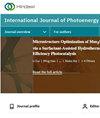基于NSGAI-MOPSO和蒙特卡罗方法的并网系统允许光伏穿透水平的随机优化选择与分析
IF 2.1
4区 工程技术
Q3 CHEMISTRY, PHYSICAL
引用次数: 0
摘要
通常,并网光伏系统的主要重点是扩大光伏渗透水平,以确保全用电覆盖。然而,由于其发电的随机性和不可分散性,会对公用电网产生重大不利影响,如电力过载、电压、谐波、电流和频率不稳定。这些影响的严重程度随着光伏系统的穿透程度而变化。因此,设计问题涉及在不确定性存在的情况下优化两个相互冲突的目标,而不违反电网的运行限制。然而,现有的研究避免了技术影响,并将冲突的随机目标标量化为单个随机目标,以降低问题的复杂性。本研究提出了一种随机多目标方法,在不违反系统运行约束的情况下,以最优成本确定电网系统的最佳允许光伏穿透水平。实现了五种前沿的多目标优化算法,并使用超容量度量、执行时间和非参数统计分析进行了比较,以获得高质量的解决方案。结果表明,混合NSGAI-MOPSO具有更好的收敛性、多样性和执行时间能力来处理复杂问题。对所获得的最优解的分析表明,即使在波动的天气条件下,实用的设计方法也可以准确地确定最大允许光伏穿透水平,以最低成本满足任何并网系统的能源需求,而不会破坏电网的运行限制。相比之下,随机方法能够开发出更可持续、更实惠的并网系统。本文章由计算机程序翻译,如有差异,请以英文原文为准。
Stochastic Optimal Selection and Analysis of Allowable Photovoltaic Penetration Level for Grid-Connected Systems Using a Hybrid NSGAII-MOPSO and Monte Carlo Method
Generally, the main focus of the grid-linked photovoltaic systems is to scale up the photovoltaic penetration level to ensure full electricity consumption coverage. However, due to the stochasticity and nondispatchable nature of its generation, significant adverse impacts such as power overloading, voltage, harmonics, current, and frequency instabilities on the utility grid arise. These impacts vary in severity as a function of the degree of penetration level of the photovoltaic system. Thus, the design problem involves optimizing the two conflicting objectives in the presence of uncertainty without violating the grid’s operational limitations. Nevertheless, existing studies avoid the technical impact and scalarize the conflicting stochastic objectives into a single stochastic objective to lessen the degree of complexity of the problem. This study proposes a stochastic multiobjective methodology to decide on the optimum allowable photovoltaic penetration level for an electricity grid system at an optimum cost without violating the system’s operational constraints. Five cutting-edge multiobjective optimization algorithms were implemented and compared using hypervolume metric, execution time, and nonparametric statistical analysis to obtain a quality solution. The results indicated that a Hybrid NSGAII-MOPSO had better convergence, diversity, and execution time capacity to handle the complex problem. The analysis of the obtained optimal solution shows that a practical design methodology could accurately decide the maximum allowable photovoltaic penetration level to match up the energy demand of any grid-linked system at a minimum cost without collapsing the grid’s operational limitations even under fluctuating weather conditions. Comparatively, the stochastic approach enables the development of a more sustainable and affordable grid-connected system.
求助全文
通过发布文献求助,成功后即可免费获取论文全文。
去求助
来源期刊
CiteScore
6.00
自引率
3.10%
发文量
128
审稿时长
3.6 months
期刊介绍:
International Journal of Photoenergy is a peer-reviewed, open access journal that publishes original research articles as well as review articles in all areas of photoenergy. The journal consolidates research activities in photochemistry and solar energy utilization into a single and unique forum for discussing and sharing knowledge.
The journal covers the following topics and applications:
- Photocatalysis
- Photostability and Toxicity of Drugs and UV-Photoprotection
- Solar Energy
- Artificial Light Harvesting Systems
- Photomedicine
- Photo Nanosystems
- Nano Tools for Solar Energy and Photochemistry
- Solar Chemistry
- Photochromism
- Organic Light-Emitting Diodes
- PV Systems
- Nano Structured Solar Cells

 求助内容:
求助内容: 应助结果提醒方式:
应助结果提醒方式:


